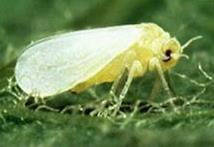Silverleaf whitefly Bemisia tabaci
Silverleaf whitefly or Bemisia tabaci was first found in Australia in the mid 90s. Overseas it is a serious pest of a wide range of tropical and subtropical fruit, vegetable, ornamental and flower crops. There are several strains of this species found around the world, each one differing slightly in its preferred host range, in the range of damage symptoms displayed, and the ability to transmit various viruses. The predominant biotype found in Australia is Biotype B which in many countries overseas is considered a separate species, Bemisia argentifolii. Biotype B infests tomatoes, brassicas and cucurbits such as pumpkin, melons, squash and cucumbers. In cucurbits, this whitefly causes silver leaf symptoms, hence the name silverleaf whitefly. Silverleaf whitefly can be found in conjunction with greenhouse whitefly.
Lifecycle and appearance
Silverleaf whitefly eggs are a light yellow/green when laid turning light brown prior to hatching. The pupae are broad and flat and do not have the distinct raised sides that greenhouse whitefly pupae show. The pupae are more pointed at one end and have fewer spiky hairs than that of the greenhouse whitefly. Adult silverleaf whitefly are slightly smaller and have a yellowish body compared with greenhouse whitefly. They also carry their wings more parallel to the sides of their bodies (abdomen is more visible from above) than greenhouse whitefly. Adult greenhouse whitefly carry their wings in a more tent shaped fashion over their bodies.
Silverleaf whitefly lay their eggs over the whole plant so it is not uncommon to find all life stages on one leaf.
Silverleaf whitefly tend to prefer slightly warmer temperatures than greenhouse whitefly. Development occurs in the range of 14-35°C. At 14-19°C development is very slow with the full life cycle taking up to 140 days at 16°C. Adults can survive several weeks without a host plant in winter. On tomatoes (at 25°C) a female can produce around 195 eggs in her lifetime.
Silverleaf whitefly have a higher tolerance to many insecticides and tend to be much harder to control than greenhouse whitefly.
Silverleaf whitefly are controlled by Encarsia, Nesidiocoris and yellow sticky traps.

Related products
- Encarsia
- Eretmocerus
- Nesidiocoris
- Yellow sticky traps & hand lenses
Related crops
- Berryfruit
- Flowers/ornamentals
- Greenhouse capsicums
- Greenhouse cucumbers
- Greenhouse eggplants
- Greenhouse tomatoes
- Melons
- Nursery




